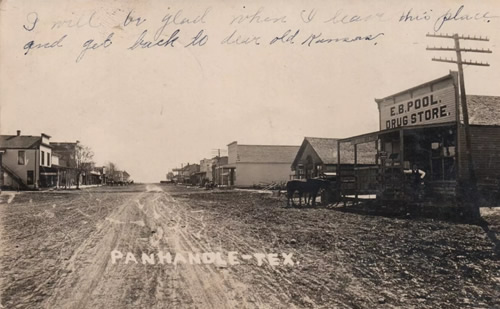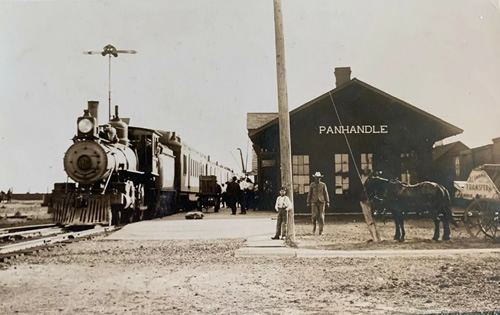Panhandle, Texas, Carson County seat. (original) (raw)
History in a Pecan Shell
A brief timeline of important events in Panhandle's history:
Panhandle was originally named with the appropriate (to the county) name of Carson City.
1887: Name changed to Panhandle - first newspaper is printed.
1888: Carson County organized - Panhandle becomes seat of government.
1888: Panhandle is terminus for the Panhandle and Santa Fe Railroad.
1900: Population reaches 300.
1909: Panhandle incorporates.
1920s: Prosperity from natural gas sparks interest in installing infrastructure.
1930s: Town is bankrupted when interest on infrastructure bonds can't be paid.
1950: New courthouse constructed.
1965: Bonds finally paid off.
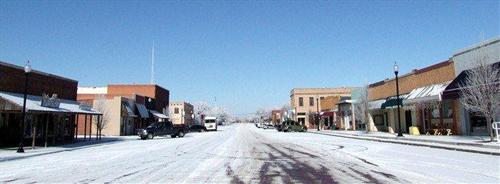
Mian Street Panhandle, December 2007
Photo courtesy Tom Jones
Historical Marker: 117 South Main (in front of Police Station)
Panhandle
In 1880s, capital of Panhandle area. Settled when slaughter of buffalo sent Indians to live on reservations. Terminus of Santa Fe Railway, 1887. Here immigrant trains brought colonists, who plowed old Indian range into wheat fields and civilization. Settlers banked here, saw the dentist, got supplies, lumber, mail, windmills, fencing. Was made county seat when Carson County was organized in 1888. Nearby is site of first oil well in area, drilled 1921. Also nearby, Pantex Farms of Texas Technological University, on site of World War II Ordnance Plant.
1965
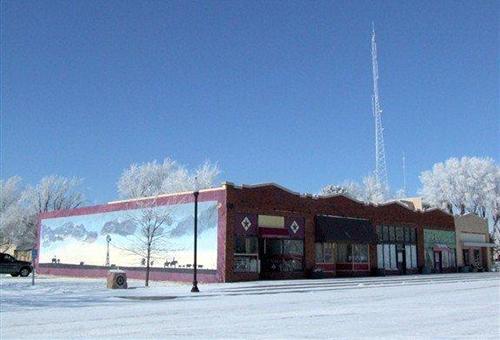
Panhandle, Texas
Landmarks & Attractions
Photo Gallery & Historical Markers

- Thomas Cree's Little Tree
Planted in 1888, the Bois d'Arc tree planted here was the first tree planted in the Panhandle region. It was accidentally poisoned in 1969 - replacement tree and markers are on US 60 - five miles South of town. - Carson County Square House Museum
In Pioneer Park on Hwy 207
City Offices are in the former Santa Fe Depot - Scenic Drive:
FM 293 West to Texas 136 North

Historical Marker: 5th and Elsie Streets, Hwy 207, Square House Museum The Square House
The Niedringhaus brothers of St. Louis sent lumber by ox-cart from Dodge City and built this square house on their "N Bar N" Ranch here in Carson County in the mid-1880s. In 1887 a railroad official occupied the pioneer cottage while the Southern Kansas Railway was being extended from Kiowa, Kansas, to Panhandle City. This was later the home of some distinguished settlers: pioneer banker and treasurer of Southern Kansas Railway Company, James Christopher Paul; rancher-judge J. L. Harrison; innkeeper James B. Wilks; and Sheriff Oscar L. Thorp. The oldest house in town, it was purchased in 1965 and restored as the Carson County Museum.
Recorded Texas Historic Landmark - 1966
Historical Marker: 5th and Elsie Streets, Hwy 207, at Square House Museum
Temple Lea Houston
(August 12, 1860 - August 15, 1905)
Born in the Texas Governor's Mansion, the eighth and last child of Sam Houston (1793-1863) and his wife Margaret; educated at Baylor University, Texas A&M, and in a law office, Temple Houston came in 1881 to this region as district attorney for the 35th Judicial District. He married Laura Cross of Mobeetie, 1882. Tall and handsome, he resembled his father-- a fact cited when he ran for the Texas Senate in 1884. He won, and was seated before reaching legal age for the office. While serving in the Senate, he built a home near "Panhandle City." During his two terms, he became a leader in spite of his youth, advancing legislation favorable to frontiersmen in this area. When a new capitol was dedicated in Austin in 1888, he made the major speech, taking pride that lands in the Panhandle had paid for the magnificent building. Amid the ovations of that day were pleas that he run for Governor or United States Congressman, but he declined. About 1893 he moved to Oklahoma and gained added fame as a lawyer and orator. Thus the fledgling of "The Raven" became a legend in his own time. He was the father of two daughters and three sons. The Oklahoma Historical Society has honored him by placing a marker at his grave in Woodward.
1976 [ Temple Lea Houston: Son of Sam by John Troesser ]
[ Temple Lea Houston by C. F. Eckhardt ]
[ Temple Houston by Clay Coppedge ]
[ Sam�s Kids - the Houston Eight by Wanda Orton ]
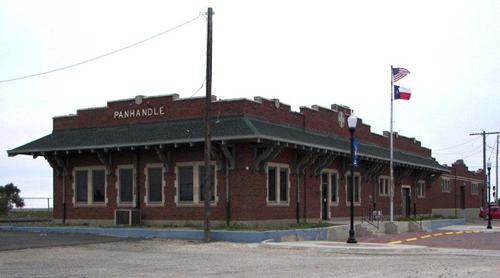
The former ATSF Depot is in use as City Offices
Recorded Texas Historic Landmark
Photo courtesy Terry Jeanson, September 2007
More Texas Depots
Historical Marker: 200 South Main Street, in front of Panhandle city hall
Atchison, Topeka, & Santa Fe Railroad Depot
The 1920s oil boom brought increased business to this railroad town, and a new depot was built here in 1928. The structure exhibits elements of the Prairie School, Mission, and Tudor styles of architecture. Prominent features include bracketed overhangs, stepped parapets, and cast stone window surrounds. One of the last brick depots built on the company's western lines, it was last used for passenger service in 1971. It became City Hall in 1985.
1988
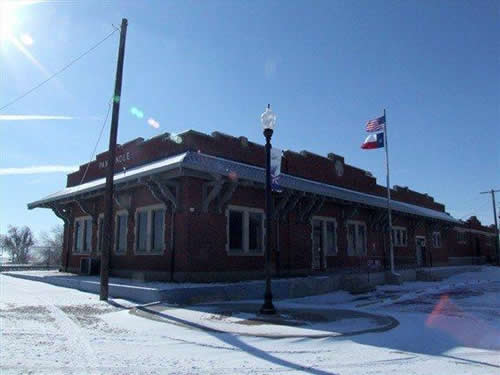
Panhandle Depot in the Snow
Photo courtesy Tom Jones, December 2007
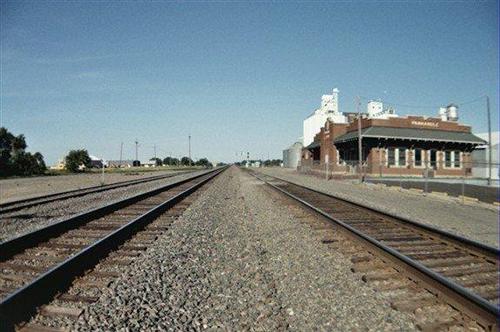

Historical Marker: 6th Street
12 blocks E of intersection with Main Street
Panhandle Cemetery
The oldest documented graves in this cemetery date to 1889, three years after the founding of Carson City (later renamed Panhandle), the first town in the county. Among those buried here are Civil War veterans and area pioneer families. Gravestone designs range from simple to elaborate, and the cemetery also contains many unmarked graves. The Panhandle Cemetery has also served people in surrounding communities. Additional land acquisitions have increased the size of the graveyard over the years, and a small chapel was built in 1965.
1990
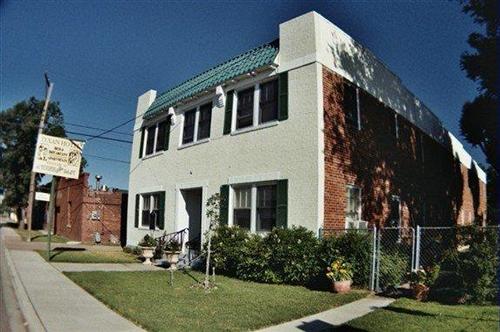
Historical Marker: 117 E. Broadway Texan Hotel
Texan Hotel During the height of Carson County's oil boom in the 1920s, the major oil field supply houses headquartered in Panhandle, and lodging was in great demand. In 1926, Clark B. (d. 1946) and Margaret (d. 1967) Downs opened the Downs Hotel to help meet this need. It was renamed the Texan Hotel when the property was conveyed to J. H. Paul (d. 1960) in 1932. Later owners converted the Texan Hotel to apartments but continued to make a few rooms available for guests after World War II. By the early 21st century, the Texan was the only hotel built in Panhandle during the oil boom years that remained in operation.
(2002)
Historical Marker: from Panhandle, take Hwy 60 about 4.5 miles southwest (on Highway R.O.W.)
First Tree
First tree on the Texas High Plains, set in front of dugout home by Thomas Cree, 1888. Good luck symbols of settlers throughout drought, blizzard and heat. Cree's bois d'arc tree died in the 1970s. County residents planted a new tree here in 1990 as a memorial to the area's early pioneers.
1963
[See Texas Historic Trees ]
Historical Marker: from Panhandle, take Hwy 60 about 4.5 miles southwest (on Highway R.O.W.)
Thomas Cree Homesite
After serving as a teamster in the Civil War (1861-65), Thadium (Thomas) B. Cree worked for the Union Pacific Railroad. In 1888 he and his wife came to the High Plains. They acquired this land and, with no trees for lumber, they built a dugout home. Cree traveled 35 miles at his wife's request to find a sapling and planted it here. He watered it from a nearby lake that he dug from a buffalo wallow. The tree never grew but lived many years despite blizzard, heat, and drought. Gov. John Connally dedicated an historical marker in 1963 to the first tree in the Panhandle.
Recorded Texas Historic Landmark
1967

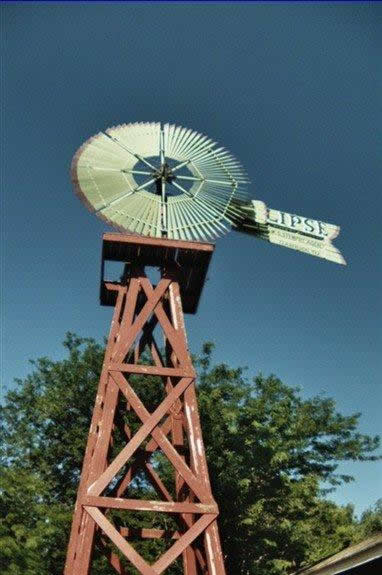
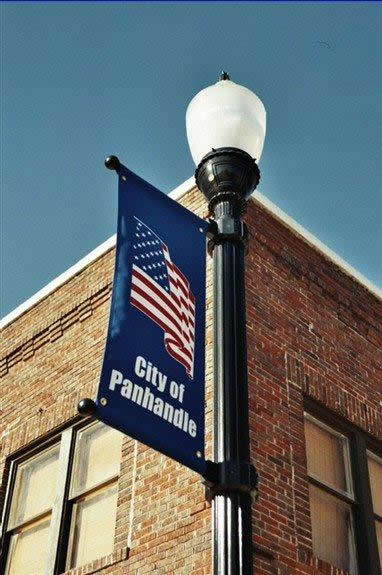
Panhandle Street Light
Photo courtesy Tom Jones, June 2007
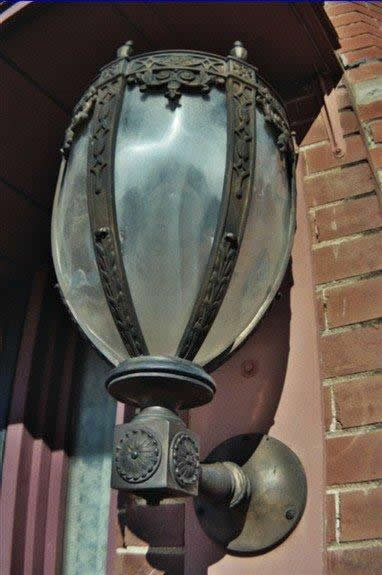
Light fixture
Photo courtesy Tom Jones, June 2007

Carson County 1940s map
From Texas state map #4335
Courtesy Texas General Land Office
Texas Escapes, in its purpose to preserve historic, endangered and vanishing Texas, asks that anyone wishing to share their local history, stories, landmarks and recent or vintage photos, please contact us.
